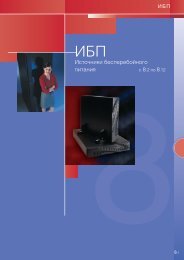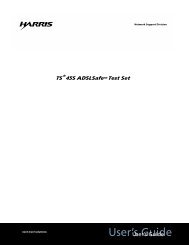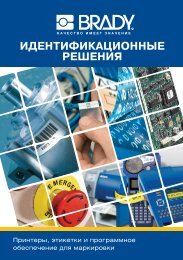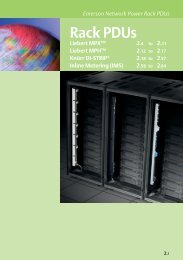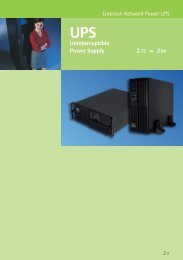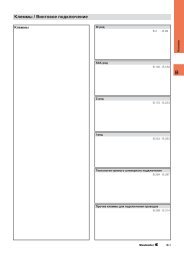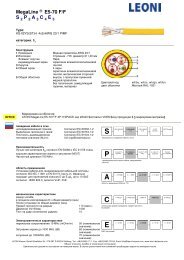100 mm
100 mm
100 mm
- No tags were found...
Create successful ePaper yourself
Turn your PDF publications into a flip-book with our unique Google optimized e-Paper software.
ATEX guarantees your safetyELECTRO-TECHNOLOGY FOR INDUSTRYDirectivesIn the Ex-Directive 94/9/EU, the European Union hasprovided a basis for binding uniform requirements forcharacteristics with regard to the protection of systems,appliances and components against explosion. Withthese standards, the manufacturer can assume whendesigning and assessing the explosion protection thathe is developing explosion-protected systems, appliancesand components that conform to the Ex-Directive94/9/EU and which are then subjected to uniform bindingtest procedures by an appointed body of the EuropeanUnion.A uniform classifi cation of explosion-endangered plantsis the basis for the selection, assignment and installationof systems, appliances and components. In orderto protect employees, the user is obliged by Directive1999/92/EU to assess the explosion risk of the plant,to divide the plant into danger zones and to draw upan explosion protection document or a series ofdocuments, which fulfi l the requirements containedin this directive, and to keep them up to date.Through directives 94/9/EU and 1999/92/EU, the prerequisiteshave been created for a complete unifi cationof the regulations for protection against explosion inthe European Union and form a closed system, withwhich explosions can be effectively avoided in orderto protect man, machine and environment.Selecting suitable Ex alarm productsThe selection of suitable alarm products is essentiallygoverned by two factors, which can be distinguishedas follows:Ex environmental requirementsGroups and gasesExplosion-protected products are catalogued withregard to their different purposes of use. The fi rst distinguishingcriteria is whether usage is underground orabove ground:Group I: operating equipment for undergroundmining with a ‘fi redamp risk’Group II: operating equipment for all other(non-group I) areasA further distinction is made in Group II according tothe types of gases present in the operation environmentand the temperature class. On the one hand, thisdescribes the maximum surface temperature of theexplosion-protected device and, on the other, the minimumignition temperature of the gas or vapour.For secure protection against explosion, it must beensured that the surface temperature of the device(e.g. the fl ashing light) is always lower than the ignitiontemperature of the gas.Classification of gases and vapours into temperatureclasses and gas groupsIIIAT1≤ 450°CMethaneAcetoneEthaneEthyl acetateBenzeneAcetic acidA<strong>mm</strong>oniaCarbonmonoxideMethaneToluenePropaneMethanolT2≤ 300°CEthyl alcoholi-amyl acetaten-butanen-butyl alcoholT3≤ 200°CPetrolDieselAviationfueln-hexaneHeating oilIIB Town gas Ethylene –T4≤ 135°CAcetylaldehydeT5≤ <strong>100</strong>°CT6≤ 85°CIIC Hydrogen Acetylene – CS 2Technologya) Ex environmental requirementsb) Functional requirementsThe gases are classifi ed in groups ABC accordingto their fl a<strong>mm</strong>ability. This in turn generates differentrequirements for the enclosures of electrical equipment.For explosion-proof enclosures, these includethe dimensions of the closure gap. The gas groups areupwardly compatible, i.e. devices that are suitable foruse in group IIC can also be used in the groups IIB orIIA. The same compatibility applies to the temperatureclasses, according to which devices from temperatureclass T6 can also be used in all other temperatureclasses. However, devices from temperature class T4are adequate for most applications.189




